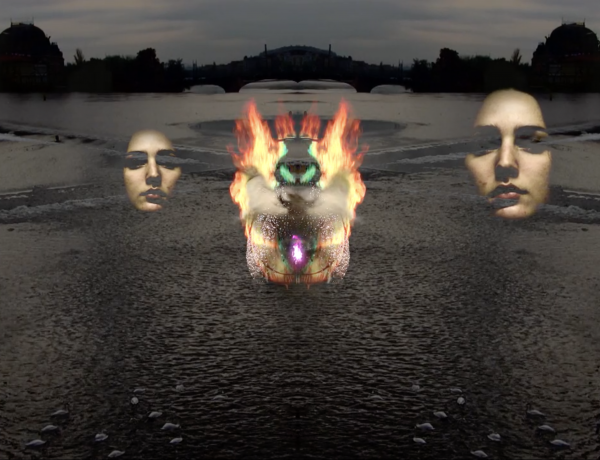
‘Like the elegantly uncanny moving pictures that anchor his career, O’Neill’s sampling of unconscious scenography operates in the gap between the hermetic and demotic, between image–fragments whose significance remains obscure and iconography familiar enough be lodged in our cultural memory banks. He describes a room with peeling walls, broken windows opening onto a view of pristine sky. There is a “desert spa built out of volcanic rock” in the distance, with a vintage Oldsmobile perched on the driveway. Removing a hubcap from the automobile, the dreamer discovers a secret cache of still photos. While examining a shot of a calendar pinup girl, the light begins to fade. As is true of O’Neill’s films, a sense of place and of architectural detail take precedence over human figures and their activities. Transiency, ostensibly the default position for all dream experience, informs even static views of quotidian objects. It is possible to read the decaying room as a camera obscura, for O’Neill a primal and recurrent site of fast–motion processions of light. Defying physical laws of gravity and mass, a landscape may be shown as nested with frames sporting divergent spatial configurations. Car, rock, photo?they are elements of a familiar dance in which machines couple with natural elements in spasms of categorical inversion. The almost irresistible temptation is to turn O’Neill’s report into a kind of rebus, which if carefully deciphered might illuminate his otherwise obscure principles of cinematic construction. From the sleep of unreason, an idiolect emerges.
‘Yet the trouble with this line of inquiry is obvious. Without recourse to the language of psychoanalysis, by which visual symbols are reread as symptoms–the superficial linkage of dream account and movie images results in merely reinforcing, not decoding, visual patterns observable in the films themselves. Moreover, the particular fabric of O’Neill’s work, especially its distance from canonical forms of expressive subjectivity, rebuffs the standard tools of psychoanalytic interpretation. To be sure, several less quixotic insights can be culled from the journal entry: that autobiographically–inflected dream material constitutes a surprising source for the filmmaker’s creative imagination; further, that his fascination with subconscious imagery taps into a legacy of Surrealism in art and film. Neither idea has been closely pursued in critical writings or in interviews, and neither will receive adequate treatment here. It is worth noting, however, that the desire to incorporate or imitate the condensatory power of dreams had been a key project in earlier avant–garde film styles, a project that gradually fell into disfavor at about the time O’Neill began to make films. While it would be unproductive to approach O’Neill’s work as, say, a late species of the Trance Film or experimental psychodrama, addressing it through modernist paradigms of material self–reference or ironic treatment of pop culture?heretofore the dominant approach?proves to be equally shortsighted. The point is that among the challenges, and substantial rewards, arising from the filmmaker’s forty–year trail of movie alchemy is difficulty in finding a consistent angle of vision, a stable historical or morphological niche, from which to address its inclusive achievement. That this is so despite ample evidence of recurrent visual patterns and enduring philosophical concerns is, paradoxically, part and parcel of the oeuvre’s larger significance. In this sense the films are at once attuned to, and examples of, deeply liminal objects–interstitial and in constant flux even within the arena of critical discourse.
‘A measure of their slippery status is glimpsed in responses that have little or nothing to do with issues of personal or social meaning, cultural allusion, iconographic or formal inheritance. Instead, the patent complexity and elusiveness of O’Neill’s images tend to elicit agonizingly detailed descriptions of what happens on screen at any given moment; how an image first appears then is transformed, rather than what it contributes to our understanding of the world. Although analogies are offered to the experience of perceptual testing or “puzzle–solving,” the tone of such reports suggests a bout of ambient dreaming. It is as if the need to ratify in memory the dazzling surface of screen activity privileges one’s immediate, sensual impressions at the expense of broader motifs, themes, tropes. A typical conclusion holds that O’Neill’s films “pose to the viewer the general problem of finding a way through a discontinuous multiplicity of meaning.” When not making a case for irreducible ambiguity or diffuseness in confrontation with the work, commentators have resorted to oddly misleading parallels: psychedelic tripping, TV channel–surfing, “dynamic graffiti.”
‘O’Neill himself has not exactly discouraged assessments grounded in indeterminacy. In program notes for Saugus Series, he writes that separate scenes in the film connect to form small stories, “recapitulations of remembered events and feelings told somehow from the vantage point of one who is half awake, on the magic edge of entering or leaving consciousness.” He has, conversely, repeatedly called attention to affinities with factual cinemas, from archival history compilations to science lectures and industrial training shorts: “I conceive of films that are very close to documentaries, but they’re not.” The straddling of generic options does not stop there: as early as 1976, O’Neill considered experimenting with methods of commercial storytelling: “One of the ideas was that I would begin to work with dialogue, begin to work with actors… knowing exactly how to finally get the lines down, get the story down.” This impulse would finally reach fruition twenty years later. The common belief that procedures associated with Hollywood narrative, with documentary, and with the avant–garde are mutually incompatible is untenable, a gross canard perpetrated by a combination of marketing demands and film–historical blindness. Nonetheless, mapping the terrain of a film career for which established generic, technical, and stylistic boundaries are merely provisional?if not altogether illusory, like a desert mirage, requires at the least a point of departure and a willingness to court disorientation. In addition, it is helpful to bear in mind a mythic ground zero, whose coordinates dictate institutional as well as social possibilities. For lack of a better moniker, we will call this central region “Los Angeles.”
‘Among supporters of the movement, the public anonymity of avant–garde filmmakers is a longstanding joke. An ironic acknowledgment of that anonymity can be gleaned from O’Neill’s stealthy appearances in his films, something like a disenfranchised version of Alfred Hitchcock’s famous cameos. In The Decay of Fiction, he takes a brief turn as a hard–boiled pulp writer, or perhaps gossip columnist, hunkered over an ancient typewriter. The opening tableau in Foregrounds casts him as an inert figment of nature, a recessive backyard monument. In Trouble in the Image, he pops onto the screen to scribble a glowing figure with a long stick, the incarnation of a cinematic sorcerer (or just an apprentice). Water and Power finds him, among other poses, with a bag on his head. Verbal references and iconographic “stand–ins” widen the metaphoric scope of role–playing to include an action painter, jazzman, detective, naturalist, and sandwich maker. Hence it is more than a cliche to suggest that O’Neill has worn a multitude of cinematic hats, several of which have received quite literal representation, like the floating porkpie at the end of Saugus Series. Mitch Tuchman once characterized his aesthetic presence as an amalgam of tinker, prospector, and magician. Born a century earlier, O’Neill might well have assisted the invention of the automobile, a prominent object among a cluster of surrogate movie–machines crisscrossing the body of his work. For all their gleaming wizardry, however, the films retain vestiges of a handmade, Rube Goldberg funkiness, the machine as unreliable contraption. Nor can we ignore avatars from the animal kingdom: dogs, snakes, and bugs are recurrent motifs, but the pack rat and chameleon are both appropriate, if unspoken, totems.’ — Paul Arthur
___
Stills

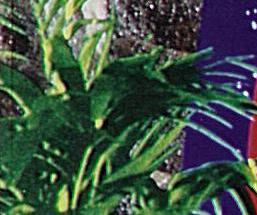



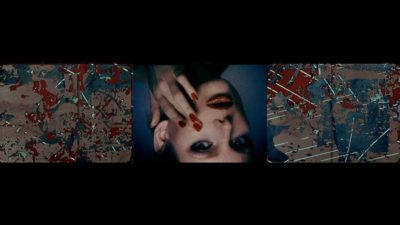
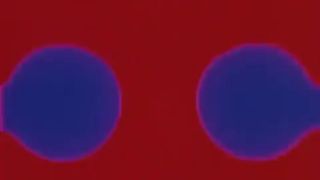
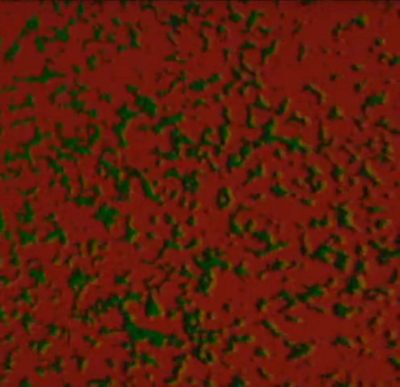
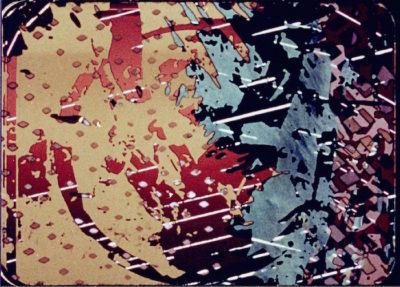
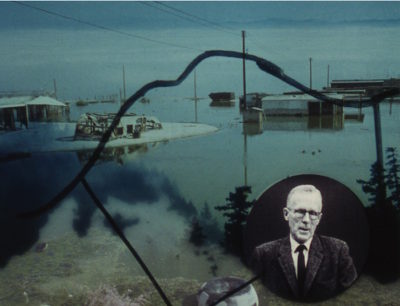
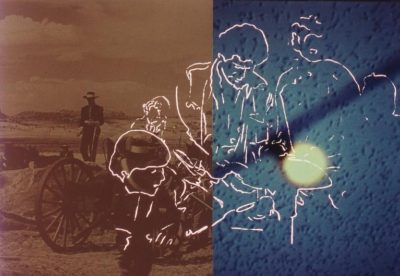



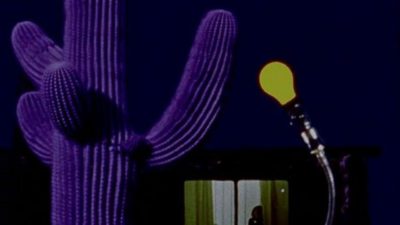


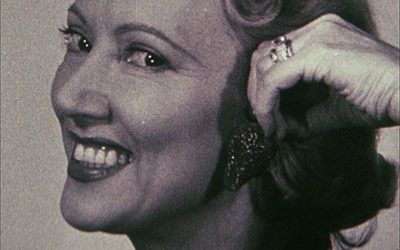
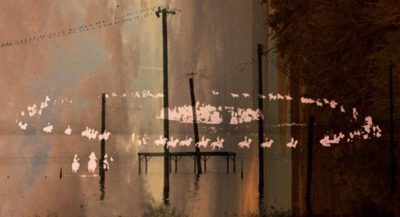

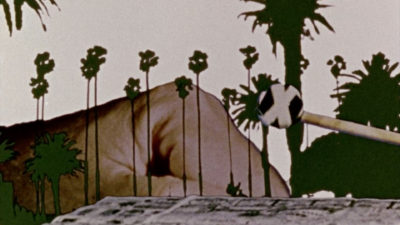
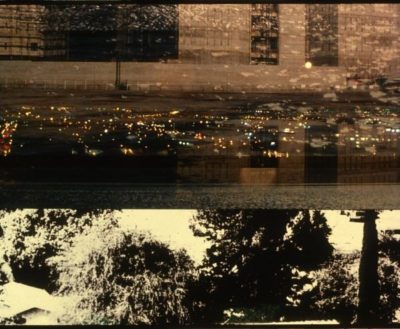
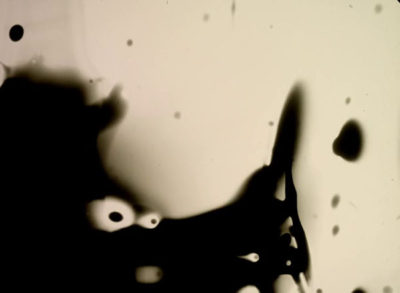
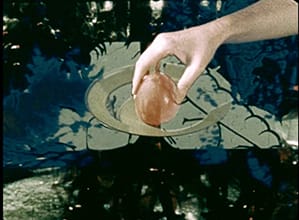

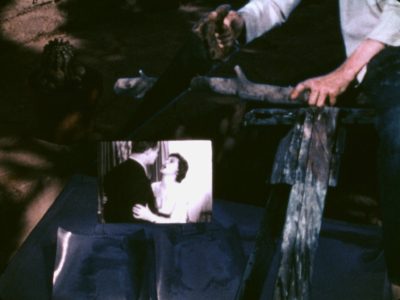

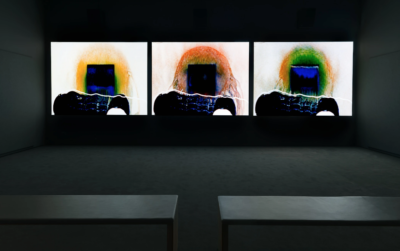










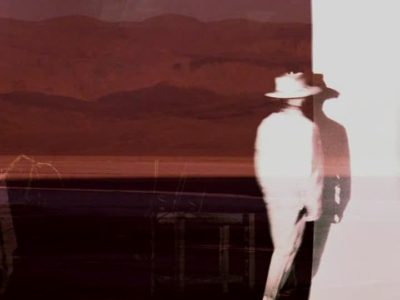
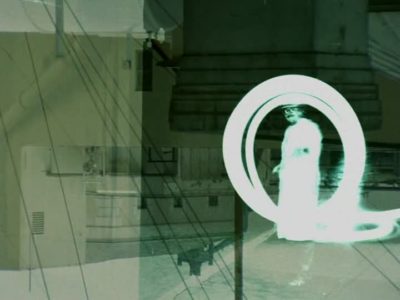
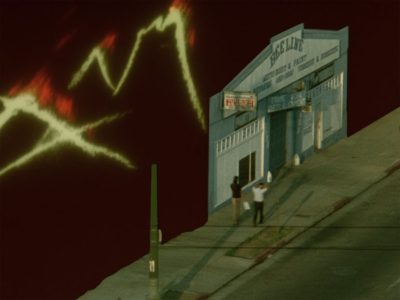

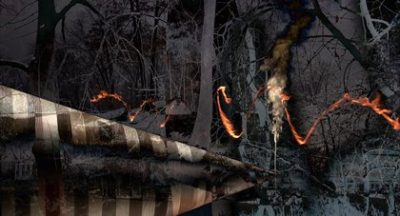
___
Further
Pat O’Neill Resource Site
Pat O’Neill @ Mitchell-Innes & Nash
Pat O’Neill @ Monitor
Pat O’Neill @ IMDb
Pat O’Neill @ Experimental Cinema
Pat O’Neill @ MUBI
DVD: ‘PAT O’NEILL : 3 CALIFORNIAN FILMS’
Pat O’Neill @ letterboxd
An Interview with Pat O’Neill
Light and Sound Machine: Pat O’Neill
David E. James on Pat O’Neill @ Artforum International
Book: ‘Pat O’Neill: Views from Lookout Mountain’
Response to Pat O’Neill’s COREOPSIS
Tracing the Decay of Fiction: Encounters with a Film by Pat O’Neill
The Strange Perceptions of Pat O’Neill
The Floating World of Pat O’Neill, Part I
Pat O’Neill – MAKING LIGHT OF IT
Pat O’Neill on Being an Exile in Hollywood
____
Extras
Pat O’Neill: E1
LAFF: Pat O’Neill – Feb. 3, 2008
Pat O’Neil LA Filmforum January 27, 2019
Pat O’Neill Oral History (Excerpt)
____
Interview
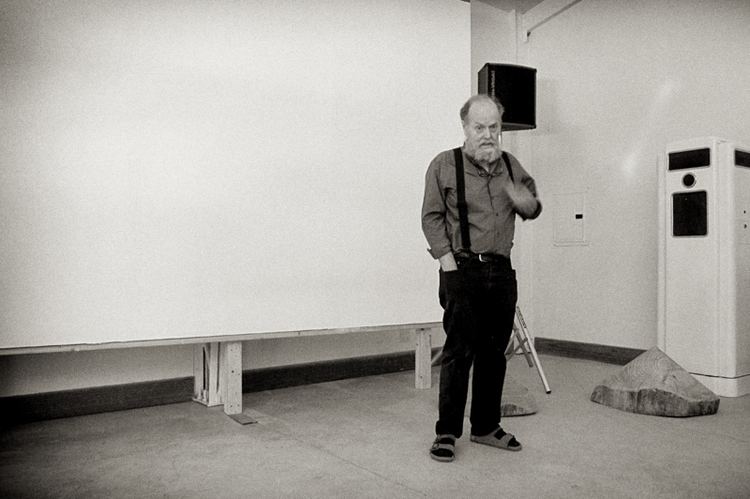
David E. James: I thought about starting with Oskar Fischinger. In the recent show of his paintings, I saw the one you own, “Happy Birthday.” I think it’s one of his best. How well did you know him?
Pat O’Neill: I never met him. I first heard of his work through Bill Moritz; we moved here to Laurel Canyon, the neighborhood in which he lived, in 1969 and he died here in 1968. I’d never seen any of his films. I guess Bill contacted Elfrieda [Fischinger’s wife] because he’d seen a print or two in Europe and that was the start of their collaboration.
DJ: But you did some work with Fischinger’s films as part of Bill Moritz’s archeology project?
PO: Yes, archival work, copying, helping him to restore some negatives in the 70s.
DJ: So your contact with Fischinger came well after you had established your own areas of concern?
PO: Yes. I finished my first film in 1962. Then I started doing abstract or composite films. I began to use the camera as a sort of gathering device to provide elements for manipulation through re-photography. This led to 7362 which was finished in 1967. I didn’t have much knowledge about the history of the medium at that time. I’d had maybe three film classes at UCLA and beyond that the midnight screenings at the Coronet and the Cinema Theater were my education. That series at the Cinema Theater was going on from the early sixties.
DJ: What kind of effect did those films have for you?
PO: I remember seeing programs at the Coronet as early as 1959. They showed all the European avant garde of the 1920s, and experimental work from New York. I had no idea what any of these films were but I was curious. I was never particularly interested in mainstream cinema, and here was an alternative. I saw Andalusian Dog, which they ran over and over again. And I saw Bruce Conner’s A Movie about the time it appeared. And Brakhage’s Dog Star Man and Maya Deren’s Meshes of the Afternoon and Kenneth Anger’s Fireworks. The Cinema Theater became a social phenomenon. “Movies Around Midnight” would pack the house every Saturday. In fact, it ran both Friday and Saturday for a few years. There was a festival two years running where they invited people to submit new films and there was a $500 prize. Bruce Baillie won one year for Mass for the Dakota Sioux. Jack Hirschman would read poetry and Ruth Hirschman was beautiful and wore big hats. It was a very demonstrative audience, at times rowdy. They always started with an hour of serials; you got a dose of old Batman and Chandu the Magician and some old newsreels. So there was this sort of audience response thing for the bad guys in the serials and then we would get down to the serious part of the evening. It was kind of a family, though I don’t remember thinking of it that way at the time. It only lasted about three or four years, and then I don’t quite remember how it was that it happened but the Cinema became a porn house and that was that.
DJ: That social group didn’t shift to a different theater or recreate itself any place else?
PO: There were quite valuable screenings at the Theatre Vanguard in the 1970s, but by then the moment had passed.
DJ: You mentioned Jack Hirschman; this would have been the Beat era in Los Angeles, the era of the Gas House. Were there any connections between the avant-garde film world in LA and the poetry world?
PO: Of course. I was fascinated with the poetry and I remember going to the Gas House in Venice when I was still riding a bicycle, from Ingelwood, where I lived. I don’t think I actually went to an event there, but in the daytime you could go in and wander around and sit in the bathtub and partake in the flavor of the whole thing. I liked to watch women who wore black. It was a big relief after Washington High School.
DJ: So, despite these screenings at the Coronet, there was no sense of independent films being made in Los Angeles?
PO: Not that I was aware of, though since I didn’t know the film makers, I wasn’t aware of where they were.
DJ: But if they were showing Brakhage films and films from San Francisco at the Cinema Theater, why weren’t they showing films from Los Angeles, Gregory Markopolous, Kenneth Anger, or Curtis Harrington?
PO: Well, they may have been, I didn’t see everything. Markopolous didn’t work in LA did he?
DJ: Yes, he was in film school at USC. Psyche was made there. There was an area of underground film activity there in the late 40s. This was also the period when the Whitneys were living in Barnsdale Park, which Bill Moritz says was the center of a film community. But the way you remember it, the LA film of the 40s and 50s was not current in this Beat era sensibility?
PO: I didn’t know about it. I was just a kid from Inglewood with no connection to anything. Then I went to UCLA, where I was sort of all over the place and finally wound up in the art school doing design. It really wasn’t until I had been there about three years that I began working in photography and encountered a couple of teachers that were very helpful. But it was still photography that got me interested in moving images. It was John Neuhart at UCLA who showed me the Whitneys’ films for the first time. I was Neuhart’s TA in the summer of 1962. John Whitney came and set up his pendulum-actuated device and also showed some of his early work. And soon after that John Whitney was working on his piece for the US pavilion at the New York World’s Fair and he showed Catalog. That one in particular was quite a revelation, the first time I had seen anything completely original in abstract film.
DJ: When you think of your work–Water and Power or the shorter films of the early 1970s–do you feel yourself to be part of any tradition? I ask because your films are not like any other films in the avant garde. Except for the people you influenced at CalArts, you’re really a school of one. Do you perceive yourself that way or do you perceive yourself in an ongoing tradition?
PO: There are certain characteristics that my work shares with the work of other artists, not all of them in film. One is a concern with perceptual ambiguity, with subjects whose presence has more than one explanation. Finding the point at which content is both unstable and balanced led me to the use of multiple images laid over one another. This was not new, of course, even at the time, but it is not an area many filmmakers have chosen to pursue, perhaps because doing so tends to hamper the flow of montage. My interest in relationships between elements in static shots has led me to make films that either have no cuts, or that have pauses between shots. It comes from my background with the still image. I am satisfied with a static camera and minimal movement. Combining imagery is also something that is difficult to do without re-photographing the original elements. The means of doing this have been largely unavailable to filmmakers, and that has tended to make it seem needlessly technical. Nowadays, combined imagery is all over the place: music videos, network promotional graphics, commercials, God knows what. Some of it very well done, beautiful even, but, of course, all of it sponsored by some corporate entity or other. Did I have anything to do with that? Perhaps, indirectly. What can you do that won’t eventually be redigested in that way? At this stage I just look at what I’m doing and try to forget everything else. All you can do is keep on.
DJ: When you talk about painting, it’s usually New York painting seen in Los Angeles: Rauschenberg, Duchamp, and Johns. Were there any L.A. artists that were significant for you?
PO: Wally Berman, of course, the assemblagist. Wally lived in Beverly Glen for a time, as I did, so I used to meet him at the market; he always had some interesting involvement with something he found in the street or something somebody said to him. Later I began to see his work; he did the posters for “Movies Around Midnight,” which were quite wonderful. I managed to save a few of those. As a teenager I encountered the car painter and striper, Von Dutch. I was very involved with automotive culture and built several cars, one of them from scratch, and did a lot of car illustrations.
I had a curious experience while I was a freshman at UCLA. I used to go to the library occasionally between classes, just go up to a random floor, and begin reading random books. One day I was looking at a 1943 bound volume of Life magazine, and I came across this article on a Salvador Dali exhibit. I had this amazing flash where I realized I was familiar with that particular issue of Life. I would have been four when I saw it, so I had sat and looked at Dali’s “Persistence of Memory” and several other works, as a kid. I later became very interested in Dali but I had no idea how that image first got in there. There was no art in my parents’ house, there was nobody interested in art or talking about it.
When I was taking painting classes in college, I tended to be involved with Surrealism and my instructors were appalled; William Brice said, “Destroy that. At least take it away!” Everyone was into figurative abstraction and painted like Matisse. So I didn’t get along in the art school at all. My mind was split between art and design. I still wanted to design automobiles: that romance didn’t die easily. I was in a very idealistic program in industrial design originated by Henry Dreyfuss in the 1950s. I was really wrapped up in that for four years and then I began to realize that I didn’t want to do the corporate thing. I knew I didn’t really want to do products. Basically I was moving shapes around. I wanted to do sculpture; I was having ideas in several media at the same time and spent all my time in the studio. I was very involved in making things, in learning about materials and processes. I took a similar approach to making movies. I was as interested in the projection situation as I was in the content of film, and learned about all of it from the point of view of making projected light phenomena.
My third film, 7362, was perhaps the most technical, most physical phase of my work. It was made right alongside of sculptures and assemblages and photo-combines.
DJ: And so you really found your voice as a filmmaker around the time that the late 60’s California hard-edge, plastic light people came together, Turrell, Kauffman, and so on.
PO: Parts of 7362 looked to me like several of Craig Kauffman’s reliefs, and I knew it at the time I was doing it. You’re moved by a work and suddenly you realize that you’ve absorbed it and it’s hanging out of your own work. Billy Al Bengston was another influence. “The Dentos,” remember “The Dentos”? Around 1965. Sergeant-stripes motifs, lacquer painted on aluminum that had been distressed with a hammer. These paintings were sort of hieratic and iconic, but at the same time Pop influenced. The subject reduced to a kind of logo. In the years that followed were two very influential moments: James Turrell’s darkened-room installations, in which a mysterious light-shape materializes and becomes a volume–a movie made entirely in one’s own perception; and Michael Snow’s La Region Centrale, in which camera movement becomes subject matter, and the screening room turns into a camera.
It was a very good period. I was sharing a studio in Santa Monica with Carl Cheng; I was productive and getting in some shows and so on. I came to a corner where I had to get serious about making films. That’s when we moved to Laurel Canyon and I had to give up the studio because I couldn’t afford both places and the drive across town.
DJ: I’ve heard you say before that your shift in filmmaking was influenced by the Beatles’ Yellow Submarine, and by a sense of a cultural optimism of that time.
PO: I don’t remember saying that but maybe I did. When Yellow Submarine came along, it seemed to indicate a change was taking place. Here, suddenly was a mass audience, high budget film that was very experimental and that dealt with perception and consciousness, albeit in a very light-hearted way. The mid-60s were extraordinarily optimistic years; it seemed things were getting better. It actually seemed that the larger culture might expand to permit, even embrace the experiences that that film hinted at. Although I was more convinced by art that actually induced experiential changes like Turrell, Cage, and Snow rather than referring to it, Submarine was a phenomenon that happened in the mainstream. It is quite strange to recall the curious things that were going on at that time, the possibilities that seemed to be opening up. It seemed too good to be true, and, well, it was.
Although I was listening to rock and roll, I was never really heavily involved with music, the energy came more from the image. I was reading John Cage’s Silence, and thinking about simplification and how you dealt with intention and how you deal with your own personality and get beyond it. I was also beginning to learn from my experiences with marijuana.
DJ: But you did work with the Single Wing Turquoise Bird .
PO: Well, I never really worked with them in performance. I used to provide film material, I knew Dave Lebrun and John Green and Peter Mays. I knew Peter from way back. We were both in the art school at UCLA in ’59 or ’60. Peter started a little film society and managed to get some money to invite artists. He invited Brakhage and Jack Smith and Gregory Markopolous. Smith and Markopolous came together and showed single rolls of the original of Twice a Man. Peter Mays was making his first couple of films, like Sanctus, on black and white super-8. For his master’s degree he presented a film. I remember it was quite an electric screening. In the following years, Peter did a string of films. He was an influence, his enthusiasm was infectious. When Cinema Theater did a Brakhage retrospective in about 1963, I remember Peter Mays went to every show. Peter Mays and Bruce Lane used to be good friends. Bruce made a UCLA student film called Unc., three minutes long, a masterpiece. And then he spent ten years working on a film based on Kenneth Patchen’s Journal of Albion Moonlight; he shot extensively and edited for years and its completion was always one of those anticipated events. Unfortunately it was never completed.
DJ: Now you are indicating that there was some underground filmmaking in L. A. . .
PO: Well, I knew a few people and I heard about others. Besides those I mentioned there were Chick Strand and Marty Muller, who moved to L.A. in 1966. Chick was at UCLA and doing wonderfully eccentric work right from the beginning. We collaborated on various projects–even made a commercial for Sears in which we did irreverent things with their back-to-school fashions. Reg Childs, who was just out of UCLA, put together a short film distribution company, Genesis, which lasted for four years and provided exposure for a number of filmmakers. Marty, Burt Gershfield, and I worked for Genesis doing, among other things, trailers and posters. And then there was the Ann Arbor Festival, the first of its kind and a place where you could go (and still can) and see a whole week of new films of every possible kind.
DJ: But despite this, there just wasn’t the momentum to create a L.A. version of Canyon Cinema or Anthology?
PO: No, there never were the cultural roots. I sent my films to the Ann Arbor film festival because I remember getting the hand bill in the mail. I think By The Sea was the first one and I think they rejected it. Then I sent 7362 and that got in. But when I sent them Runs Good, they gave me first prize. Then there came the coveted invitation to go to New York and do a screening at Millennium. I had some trepidation about how the film would be received. I was reading Film Culture by then, and figured I might get fried. But I had a screening and it was very warm and accepting; well attended, no attacks, no problem. Then there was a Cineprobe at the Museum of Modern Art. It always seemed that the community was there and in San Francisco, and you just sort of accepted the fact that filmmakers disregarded L.A., though audiences liked to hear stories about the excesses of the industry. I thought a lot about moving, but I didn’t.
DJ: The next attempt to create an community would have been Oasis, which was started in 1976. You were one of the founders of Oasis?
PO: Roberta Friedman and Grahame Weinbren who were at CalArts were really the instigators. And Morgan Fisher, David and Diana Wilson and Amy Halpern, who had just come from New York. It seemed like there was a mass of about 8 or 9 people who came and went.
DJ: Did Oasis have any effect on your own work or was it more of a social environment?
PO: It was more of an attempt to make a community that one hoped would grow and would correspond with Millennium and the Cinematheque. The circuit of traveling filmmakers was a vital ongoing thing through the late 1970s and early 1980s. There was a lot of new work, there was writing about the work, and there were grants to support non-profit venues. It was an opportunity to present (and often to see for the first time) new work, particularly challenging pieces that would not be shown anywhere else. Keeping the screenings going was a great deal of work for a number of people, all of whom had other involvements, and finally the energy began to flag. Oasis never had a permanent home, and eventually the prospect of setting up another room full of folding chairs was just more than anyone wanted to bear. I don’t know if it had any effect on my work. A few friendships from those days have endured. By 1981 everyone was tired. Amy Halpern and Paul Arthur tried to revive it in ’82, but couldn’t get a place to do the screenings.
I remember I was going to do a show of my own stuff when Oasis was housed at LAICA. I showed up the day before and I noticed that someone had built a wall across the theater; between the screen and where the seats were supposed to go an exhibit had gone up. They just forgot that there was a screening and we had to cancel.
DJ: You mentioned earlier that when you were a student you were split between art and design. It’s that kind of bridge between mutually incommensurate spheres that’s really produced the uniqueness of your work, your connections with the industry and industrial kinds of production on the one hand and the aesthetic sensibility that’s associated with the avant garde on the other.
PO: I think there are several questions at work here. One has to do with the materials and, to an extent, the subjects of my work, and another with the necessity of making a living and paying the costs of an art process that has turned out not to be entirely self-sustaining. About the second. Most independent filmmakers support themselves and their work by teaching, usually in an art school or a university film department. I did this for a time, and it was a more or less satisfactory experience, although I soon realized that it would prevent me from becoming immersed in a working process that would require concentrated attention over a period of time. Teaching is a start-stop start-stop kind of life, where one must always be thinking about next week’s classes, and so on. I decided to opt out, and instead try to work sporadically in the free-lance model, hopefully making as much in a few months that I could in a year at school, and to have actual free time, and the equipment to work with. It actually did work out that way, for a while, and that may help to explain why someone such as me might live in Los Angeles. Starting in 1976, I worked on commercial projects, bought two optical printers, and set up a modest studio. The early 80s was a time of expansion in special-effects work, and even a small shop, such as mine, could, occasionally, have an involvement in a large project. During those jobs, as many as six people, most of them filmmakers on their own, would have jobs. (Some of them: Beth Block, Tom Leeser, Tim Shepard, Diana Krumins, Sandra Matthews, David Tucker, Diana Wilson, George Lockwood, Lisa Mann.) Of course, the reality of business is risk–not every job is profitable, and there are periods of extraordinary anxiety. Often the hiatus between jobs came to be occupied with looking for work, not concentrating, as I had hoped, on the process of filmmaking.
And then, of course, there is the question of what this is doing to you while you are doing it. I mean, it encourages habits of cleanliness, sobriety, and reliability, which are all good, to a point. It also tends to make one a bit indifferent to the implications of work at hand. This is the industrial model, after all, in the entertainment business. Most, if not all of what one does may be completely trivial and besides, nobody asked for your opinion. You learn to be satisfied if your client is satisfied. You build partitions in your mind to keep from worrying about thing over which you have no control. And then, one day, you try to remember what it was you were thinking about when all this started. . .
Anyway, David, the other part of your comment I think brought to mind the question of the aesthetics of the process–the by-products of the processes of special-effects work. I mean the support materials, the offscreen stuff, never meant to be seen, that which undermines the illusion. That seems to be a very powerful thing–the illusion and the denial of the illusion, both present at the same time. For example, opaque black mattes, film used to hide part of an image so as to replace it with another, have a fascination that comes from their incomplete descriptiveness. The edges of shapes are hauntingly photographic, yet their center is vacant and flat. Characters are both knowable and invisible. This is a technology particular to a very specialized craft, which I am re-using, if you will, in the spirit of collage.
__________
16 of Pat O’Neill’s 34 films
__________
7362 (1967)
‘ 7362 revisits one of the cornerstones of the European avant–garde of the twenties, Fernand Leger and Dudley Murphy’s 1924 Ballet mecanique. O’Neill’s initial plunge into split–screen aesthetics, the film reanimates shots of an oil pump and a female dancer, printing mirrored variations of their movements split along a vertical axis. Besides being edited into aggressively strobelike patterns, the original images have been further denatured by intense color permutations, especially in the red–purple–blue range–and the flipping of foreground shapes from positive to negative. The result has predictably garnered comparisons to a high–speed Rorschach test, flashing abstract patterns onto which an individual subjectivity projects anxieties or desires. A stronger implication lies in O’Neill’s erotic coupling of female body and mechanical rig. In Leger and Murphy’s film, isolated fragments of a woman’s lips, eyes, and other body parts are juxtaposed with the movements of factory components and common utensils in order to secure their metaphoric identity: bodies are like machines and machines possess similar aesthetic properties to the human form. In 7362, the presence of machines requires no backhanded defense while the yin/yang prospect of categorical merging remains exempt from either horror or celebration.’ — Lookout Mountain Studios
the entirety
______________
Runs Good (1971)
‘A darkish journey down memory lane, to visit some news events, folkways and thought patterns associated with the late forties and early fifties.’ — PON
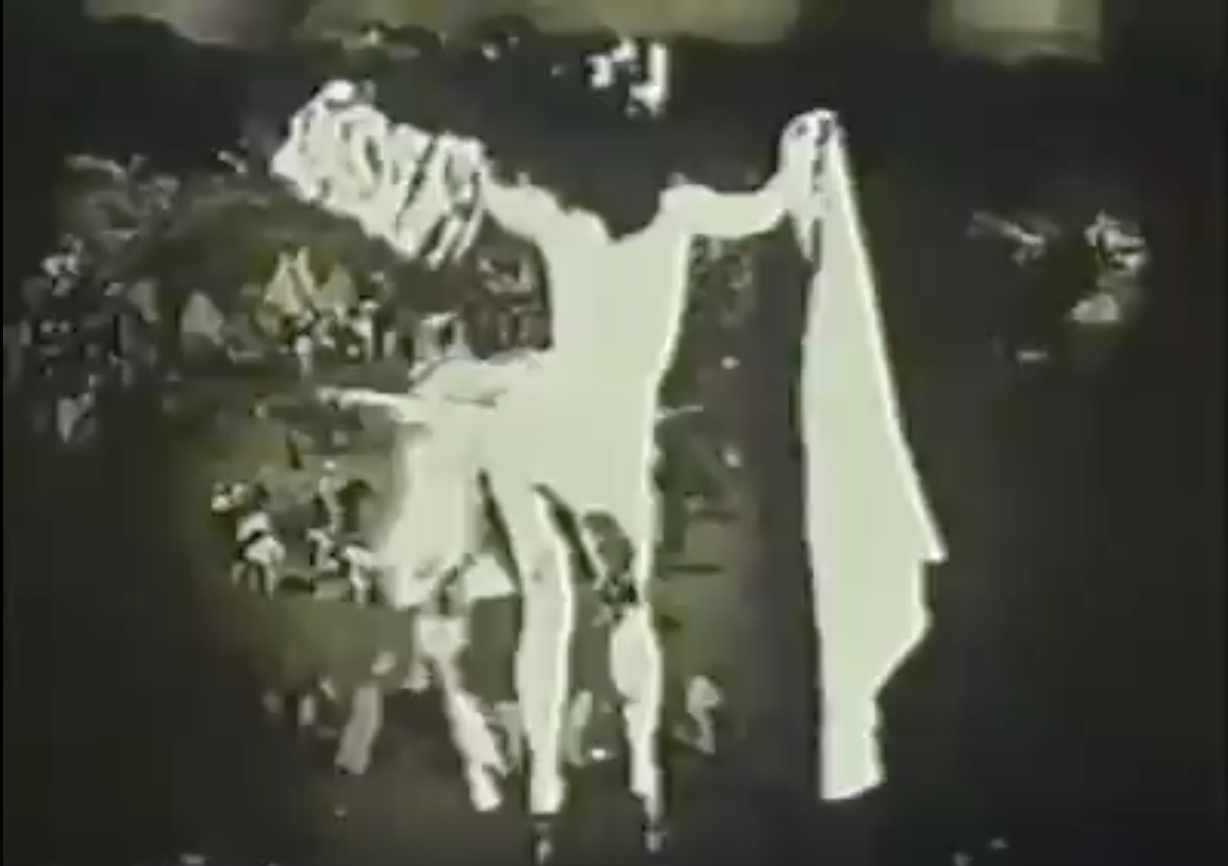
Pat O’Neill on Runs Good
____________
Easyout (1971)
‘Has to do with a consideration of one possible conceptual model for human existence: that of a primitive form of yardchair, upon which sits The Creator, impassively observing the inexorable flow of His mountains.’ — letterboxd

______________
Last Of The Persimmons (1972)
‘LAST OF THE PERSIMMONS opens with a black-and-white image of a main inflating helium balloons in the shape of rabbits. Onto this image Mr. O’Neill places two mirror images an old Fleischer-style cartoon elephant comically licking its mouth as if in anticipation of yet another layered image, that of a ripe persimmon.’ — Manohla Dargis
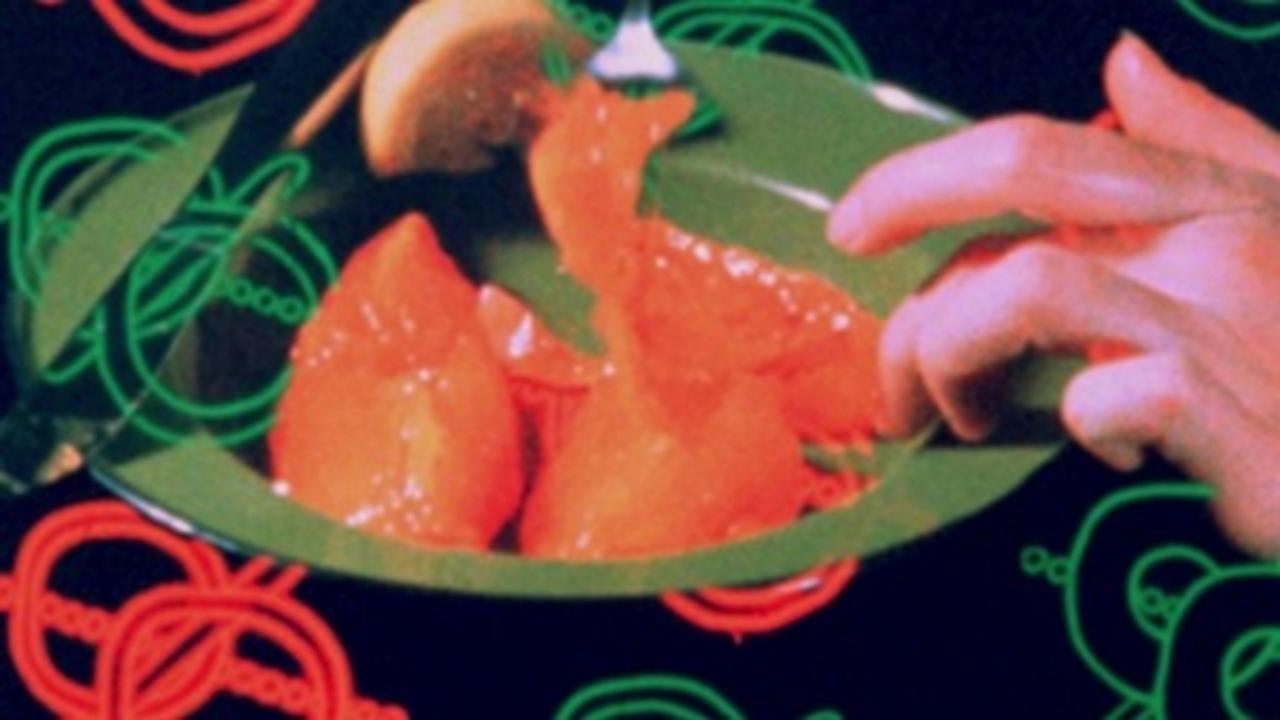
_____________
Down Wind (1973)
‘A thoughtful treatment of some of the problems we (mankind) have been having in dealing with our fellow species, animal and vegetable. Actually an undercover “structural” film, this one seems at first to be some sort of berserk travelogue. I spent years going to travelogues as a child, and still have a great fondness for visiting natural history museums in strange cities.’ — Pat O’Neill

____________
Saugus Series (1974)
‘Saugus Series is comprised of a number of individual sequences, separated from one another by intervals of black. Each of these sequences is made up of a number of image elements that are present throughout the duration of the scene. Scenes are edited into a continuity and accompanied by sound, but could, alternatively, be presented as separate experiences within a viewing space. Thus the present sequence is only one of many ways the film might be experienced, and no part of the film is particularly contingent upon any other part.’ — LA Filmforum
Excerpt
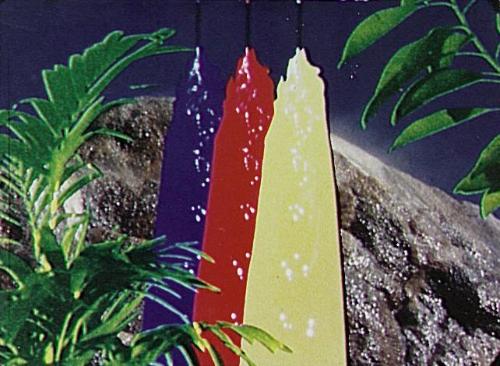
______________
Sleeping Dogs (Never Lie) (1978)
‘Considers one possible conceptual model for human existence.’ — letterboxd

______________
Let’s Make a Sandwich (1978)
‘As a number of critics have pointed out, the title of O’Neill’s film Let’s Make a Sandwich refers not only to one of the pieces of found footage that make up the film, but to the process of its making, to the layers and sandwiching of the image. That parallel physical surface and his artisanal production of it might link all of O’Neill’s work across media and position it as well toward the graphic-the flattening contour line of the cut out-and to collage, both in its cut and its combination as its dominant term.’ — letterboxd
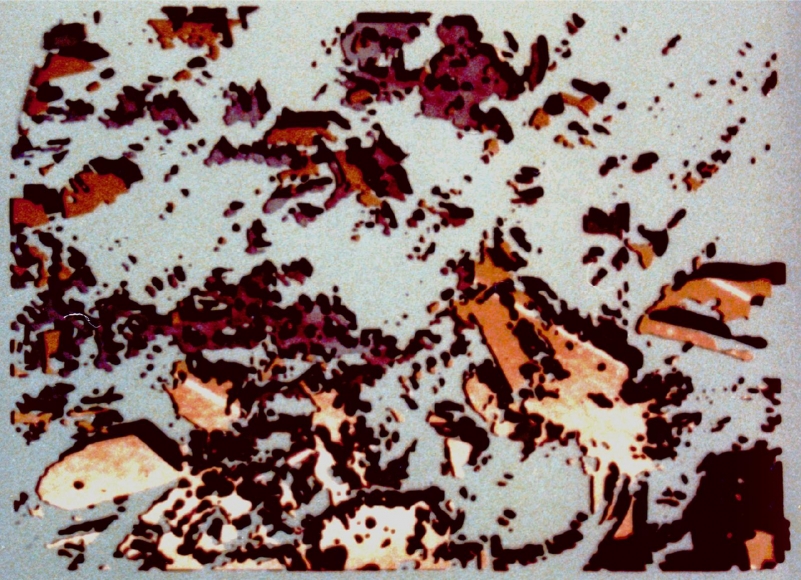
______________
Foregrounds (1979)
‘Paysage, Architecture, Urbanisme, Ville.’ — Light Cone
Excerpt
_____________
Water and Power (1989)
‘Pat O’Neill, one of the most interesting filmmakers in America today, offers a dazzling reflection on the conflict between nature and man in Los Angeles, or the desertification of the city’s surroundings due to its enormous water consumption. More interestingly, it is also a film in the age-old tradition of city symphonies: a film about LA’s foundation myths and the dreams it embodies, about its history and (grim) future, its topography and ethnography. O’Neill uses footage from several classic films to recreate the several layers of meaning emanating from the city, juxtaposing images and fantasies and hardly ever allowing one picture to go untouched. George Lockwood’s swarming soundtrack is likewise composed of conflicting languages, an elaborate work of plunderphonics in which snippets of sound stolen from movies collide with electronic soundscapes, contemporary chamber music, improv, and what not.’ — letterboxd
Excerpt
Pat O’Neill on Water and Power
______________
Trouble in the Image (1996)
‘In O’Neill’s playful, beautiful film, “trouble in the image” may take the form of a disturbing moment in a narrative, how-to instructions for creating an image, or pictures that break apart and lose their literal meaning. “The film [is] made up of dozens of performances dislodged from other contexts. These are often relocated into contemporary industrial landscapes, or interrupted by the chopping, shredding, or flattening of special-effects technology turned against itself. . . . The reward is to be found in immersion within a space of complex and intricate formal relationships” (Pat O’Neill).’ — bampfa
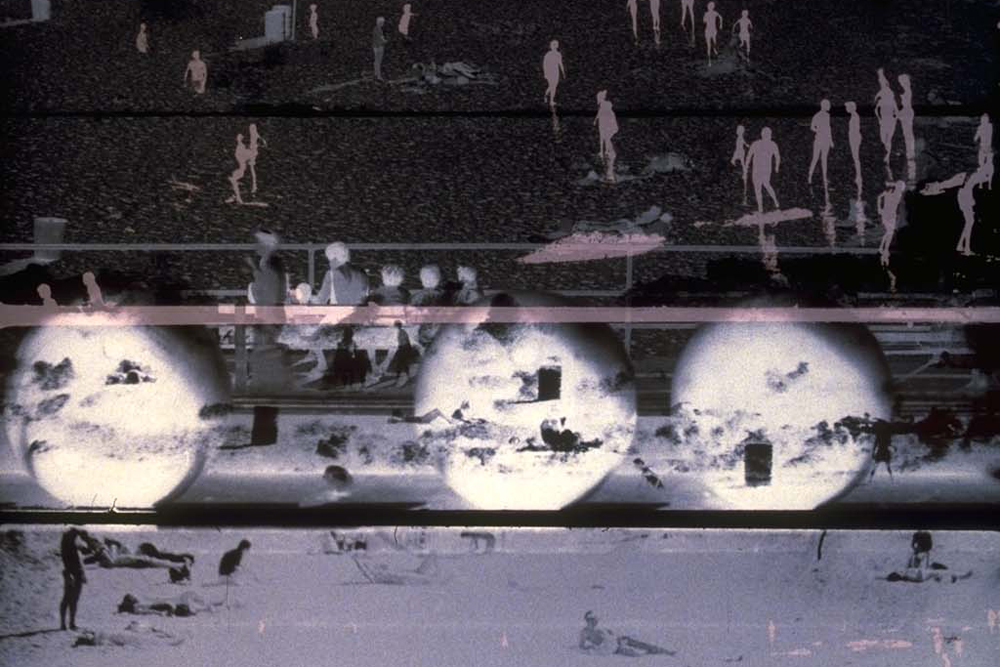
______________
Squirtgun/Stepprint (1998)
‘O’Neill applied film developer to film stock using a squirt gun, then rearranged the results into rhythmic repetitions.’ — letterboxd
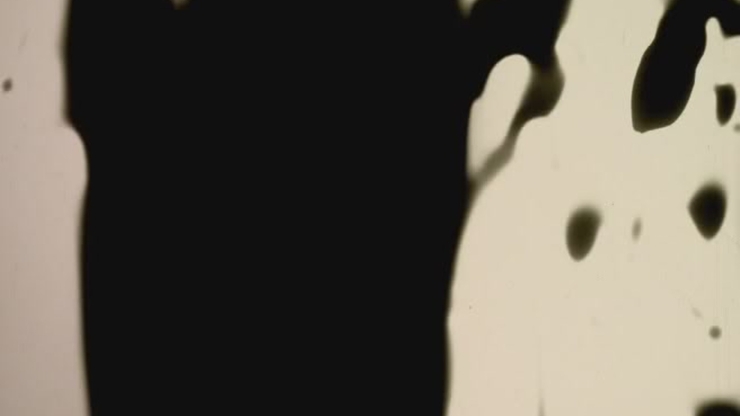
_____________
The Decay of Fiction (2002)
‘The Decay of Fiction is an intersection of fact and hallucination in an abandoned luxury hotel. The hotel is in Hollywood. The walls of the Ambassador are cracked and peeling, the lawns are brown, and mushrooms grow in the damp carpets of the Coconut Grove. The pool is empty, and the ballroom where Bobby Kennedy died is shuttered and locked. A tall, elegant blonde stands transparently on the terrace of her bungalow, smoking and watching the sunrise. Voices and tinkles waft across the lawn. A contingent of various sinister men arrive and ask for Jack. Jack is expecting trouble, but not this kind of trouble…” (Pat O’Neill)
‘“I scribbled the words The Decay of Fiction on the back of a notebook almost forty years ago, tore it off and framed it fifteen years later, and have wanted ever since to make a film to fit its ready-made description. To me it refers to the common condition of stories partly remembered, films partly seen, texts at the margins of memory, disappearing like a book left outside on the ground to decompose back into the earth. The film takes place in a building about to be destroyed, those walls contain (by dint of association) a huge burden of memory: cultural and personal, conscious and unconscious. To make the film was to trap a few of its characters and some of their dialog, casting them together within the confines of the site. The structure and its stories are decaying together, and each seems to be a metaphor for the other.” (Pat O’Neill)’ — Canyon Cinema
Excerpt
______________
Ambassador Teardown (2008)
‘Self-explanatory’

______________
Where the Chocolate Mountains (2015)
‘A dense audio-visual journey through the unconscious of the city of Los Angeles and California’s Chocolate Mountains, which have long been used by the US Navy and Marines for aerial shooting practice. Haunting digital motifs are combined with footage shot in Los Angeles, Mexico and Prague, intimate portraits and accented by nods to other filmmakers and film genres. Audio samples from rare films and 78 RPM records are layered into an uncanny soundtrack, elaborating the dynamic web of associations evoked throughout the film.
‘Where the Chocolate Mountains fully delivers the richness, sophistication, and allusiveness one has come to expect from O’Neill’s work. It makes a compelling case for his unparalleled skill as a creator of densely layered images and sound mixes and as a virtuoso of the mono genre—the urban essay film of hallucinatory intensity that ranges freely across culture and cinema history’ — Artforum

______________
Berlin, 1990 (2016)
SD video converted to digital. TRT: 27:42 minutes, loop
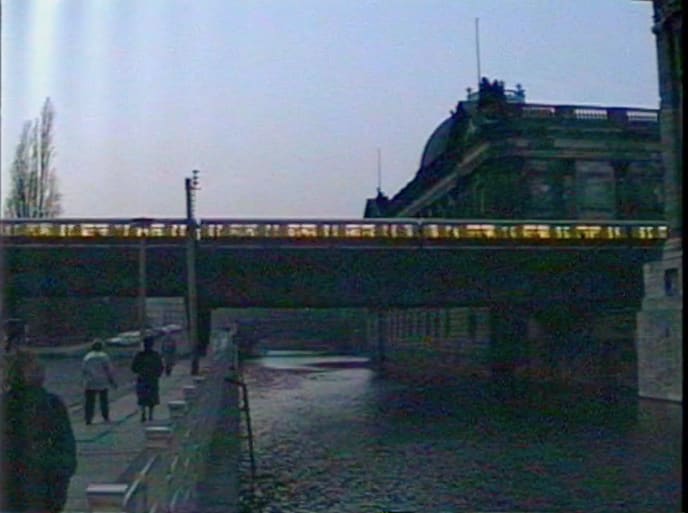
*
p.s. Hey. ** Ferdinand, I will do my best. Using whatever it is that you’ve got and that feels like it’s charging to get out of you is fiction making’s only golden rule as far as I’m concerned. I look forward to reading your thing. Everyone, Ferdinand has new short fiction piece up and at our disposal. It’s called ‘Saterday at a brown bar café’, and it’s here. Well, Cixous is known as a thinker/ philosopher/ theorist who writes excitingly, so, in terms of intentionality, it’s not prose poetry, but I can see where you’re coming from and ‘eye of the beholder’ and all of that. Russel Edson is one of the prose poetry biggies, for sure, if not the inventor (?), I’m not sure. Check back to JM’s comment of yesterday as a part of it was for you. Good day! ** David Ehrenstein, Some of those playgrounds look as though they’ve been around since Gogol’s day. ** _Black_Acrylic, Hi, B. ‘Gutter’ seems cool. Do you qualify enough to submit something to it? ** Brendan, Hi, man! How is pandemic hell treating you? ** G, Hi. Yes, imagining any child growing up playing in those playgrounds and who they might become as a consequence definitely leads to an unsettling feeling. I’m with you. My toe is making me very impatient, but I can do patience if need be, and so I am. Thanks about the Zoom. Everything groovy with you? ** JM, Hi, Josiah. I’m pretty sure the vast majority of those playgrounds are beleaguered semi-survivors of the Soviet era. Russian porn is to other porn as ghosts towns are to major metropolises. Oh, wow, interesting about that slide and the Jackson film. The priciness of ‘WRONG’ is weird and a drag. Diarmuid’s strong associating of O’Hara’s poems and my stuff is interesting to me too because, in truth, I like O’Hara’s poetry like most sane people do, but the strong association he creates between O’Hara and me is news to me as well since O’Hara wasn’t the god to me that Diarmuid is positing he was. Ashbery, Schuyler, and James Tate were much bigger for me. Oh, wow, excited for ‘Circles’. Do an alert somewhere to indicate how it can be scored. I’m looking into Evan Isoline’s work. His review of ‘WRONG’ was so great, and I barely know his work, so I’m catching up and digging bigly. Sorry you’re in a stressful phase. You’re not alone, which is no comfort. I’m all right. Impatient to get some things moving forward that need others to be propelled, and those others are still on their holidays, grr. But I’m fine. No, new news on ‘I Wished’. If I don’t hear something from the publisher soonish, I’m going to see if I can chase down some cemented stuff. Pub quiz … I thought you guys were locked down. Good that you’re not, to that extent at least. ** Right. I’ve been hoping/trying to do a Day on the fantastic films and videos of Pat O’Neill for at least five years, and only now has enough of this stuff shown up online to make that possible. His work is terrific and exciting, if you ask me, which you didn’t, but, in any case, I urge you to investigate the goods at hand. See you tomorrow.




 Now available in North America
Now available in North America 
@JM: thank you Josiah , I put those suggestions on a list
Thank you Dennis. I dont mean to overwhelm the blog with my fiction experiments but while the commentary queue is not too long im going to squeeze ur sponge one last time and please take your time when you do have the time. I revisited the carcrash theme in a short piece and seem to explore apathy but as with another short piece I ask myself if im not showing off and If im coming from the right place, becauce the subject matter is dire. What Im trying to get at is I dont want to be coming from a sensationilist exploitive place, like say how you feel about Lars von Trier films you know. Im hoping that you could when you have the spare minutes see if you might have advice on these two short pieces (3 minute read each) and if anyone else has feedback about the place where these two pieces are coming from, Id appreciate it. Its short and minimal.
1. Drive me home
https://bookssleeper.wordpress.com/2020/08/26/drive-me-home/
2. June
A reading uploaded to youtube:
https://youtu.be/fWTJL83XwT0
Dennis, I tried to get on here a few times yesterday but to no avail. Kept getting a message about the host server or whatever. Ah, the glorious times we live in and its technology…
I guess it’s good that David takes care of himself and his appearance. But that $167…that was crazy, hahaha. We talked last night and eliminated some things from his list to make it more manageable.
Toe hacking is underrated. I’m actually thinking about hacking off my lower right back. Been fucking killing me, particularly in the morning. Ugh.
Pat O’Neill is pretty damned wonderful
I think associating you with Frank O’Hara proceeds from the fact that he was the center of the action for the New York Poets in a way that you’re the center of the action for a lot of writing today. Temperamentally you’re a lot closer to Ashes. O’Hara was profoundly camp — and that;s way outside your wheelhouse
Did you get the chapter of “Raised By Hand Puppets” I sent you?
I’m new to the work of Pat O’Neill and yes, it’s really great. Given mainstream cinema’s problems, it would be nice to think that that his kind of avant-garde filmmaking might capture the popular imagination. Sure he cares not but I do wonder.
At long last my short story Piotr’s Paphiopedilum is online here at Tiny Seed Journal.
Oh, I love that opening image!
Now that you’ve mentioned it yourself, I have to admit I was also perplexed by the association that is made in WRONG between your poetry and O’Hara’s. I would like to think I am sane so I appreciate his poetry too, but the intensity of your poetry is like on a whole nother level. One of the arguments in WRONG is that like him, you tend to use real people’s names in your poems, which I personally don’t think is a poetic technique invented by O’Hara. Persian poets, for instance, have been doing this since literally centuries ago. And I’m sure there are some other Western examples too. I just wouldn’t necessarily associate that with O’ Hara? One of the the other arguments in the book is that you were so influenced by him that you even had an O’Hara-themed birthday party ‘in June 1982’ – (also why in June and not January?). There are some more arguments though, for instance, that you both mediate ‘between individual and communal concerns’… Anyway, I don’t know, but I wasn’t terribly convinced by this part either. And please don’t get me wrong, I absolutely cherish and treasure Diarmuid’s book and he is an amazing scholar. I’m just raising this specific point just because I found it a bit confusing too. As for the priciness of the book, I think that’s unfortunately the normal pricing for academic books.
I’m okay, thanks… Was just wondering if you received my book – which I posted more than a month ago? I got so excited and elated about posting you my books that I think I probably crushed the receipt in my sweaty fist afterwards, so I’m afraid I can’t track it now. I can resend it to you though if you haven’t received it yet – obviously if you’re still interested.
Really sorry about the toe situation – sending lots of love your way.
I was admiring the intriguing stills, then realized later that I’ve enjoyed The Decay of Fiction (at the Roxie, I believe). Will definitely explore more.
Our air quality has been up and down. More reason to get shit done at home, haha. This is tasteful music for such situations:
https://mikroton.bandcamp.com/album/sink
Steve, glad you enjoyed The God In Hackney. I found out about their earlier album (also great) through Dennis, so I can’t take much credit.
Bill
Hi, D., Pat O’Neill was a huge part of my journey in art consumption and creation and coloured a lot of my early forays into experimental film alongside Bill Viola and Ben Russell and lots of those other crazy, insane Americans. On WRONG and O’Hara: sometimes academic work benefits from creating these tethers or through misrepresenting these tethers. I’ve found it really interesting, regardless, and really enjoyed the excuse its given me to extra-indulge in O’Hara’s stuff at the very least. Re:Circles, yeah, I’ll definitely throw an alert up on FB and probably drop it in a comment here as well. It’s probably too small for a welcome to the world type thing, but if I get the chance I might look at compiling a general ‘SELFFUCK DAY’ because that online site is just incredible as well. There were some poems posted by Gion the other day that totally floored me in a really specific way I haven’t been since first reading ‘The Dream Police.’ Best of luck with getting cement down on that I Wished front, I’m the same in that I’m a total ‘do-er’ and love to JUST GET THINGS MOVING. And a pub quiz, yeah — our lockdown is probably too complicated to describe to those overseas this time, but the short version is that we’re doing a regional thing. I’m located in Christchurch, which is pretty much fine (and the Mosque shooter’s trial comes to a close today) in terms of the virus. Auckland is our only city in a full state of lockdown, so the rest of us can continue living a semi-normal life. It seems to be working, but this outbreak is a more complex one because it’s spreading through our Pasifika community which means there is an added layer of complexity due to a distrust of doctors because of structural racism reasons. Thinking about France a lot lately.
Best,
J
Hi Dennis! The pandemic fucking blows, but I’m not saying anything super profound here. I’m okay though. Staying home and trying to make stuff and be creative. It’s the only way. Super happy with how my photo project is going. I’d be lost without it. Love you, Man!
B